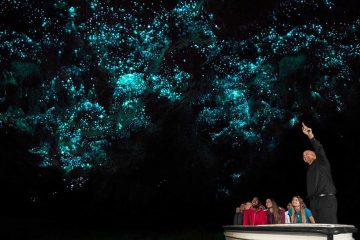Spelunking with a Difference in Waitomo, New Zealand
New Zealand’s natural landscape is incredibly varied. From white-sand beaches and rolling green hills to crystal clear lakes and snow-capped peaks — not to mention glaciers, fjords and volcanoes.
These may be the things that come to mind when you think of New Zealand, but the island nation is also home to dozens of cave systems, including the Waitomo Caves, home to some fascinating — dare we say, illuminating — creatures. Yes, we’re talking about glowworms.
What’s a Glowworm?
Glowing in the absolute darkness of a cave, glowworms look like stars, clustered together into different constellations. Heightening the illusion of the night sky, younger glowworms are brighter, appearing closer, while the older, dimmer glowworms appear further away.
They are truly awesome, in the original sense of the word.
But what actually are they? It turns out glowworms aren’t really worms at all, but bioluminescent fungus gnat larvae — doesn’t glowworm sound nicer though?
There are several different kinds of glowworms in New Zealand and Australia, but Waitomo is home to arachnocampa luminosa. After hatching from eggs, they spend between six and nine months as larvae, attracting mosquitoes and similar insects with their blue-green glow and catching them with “fishing lines” made of material similar to a spider’s web.
After all this build up, their lives as adults are somewhat anticlimactic. No longer glowing, they spend around five days as adult flies, just long enough to mate and lay their eggs.
Glowworms live in dark, quiet places near water. They can sometimes be found on tree branches along forested river banks, but they especially like caves due to the lack of wind, which can tangle their fishing lines.
Visiting Waitomo Glowworm Caves
While there are several places in New Zealand you can see glowworms for free (and by all means, seek them out!) the Waitomo Caves tour is in a league of its own and definitely worth paying for.
On your tour you’ll be guided through limestone chambers formed over millions of years, adorned with intricate stalactites (which hold on “tite” to the ceiling) and stalagmites (which “mite” one day reach the roof) that grow just one cubic centimeter each year.
As you make your way through the ancient cave you’ll learn how these formations were created, how the cave itself came to be, and the story of its discovery and exploration in the late 1800s by Maori chief Tane Tinorau, whose many descendants own the land to this day. You’ll also learn more about the cave’s famous residents, the glowworms.
Deep in the belly of the cave, you’ll climb aboard a boat bound for Glowworm Grotto. Soon you’ll be gliding silently down the underground river beneath myriads of glowworms, in their effort to attract a meal also attracting people from all over the world.
The Logistics
Waitomo is about a two-and-a-half-hour drive from Auckland and Tauranga, and just under two from Rotorua and Taupo.
Tickets for the Glowworm Cave will set you back…
- $51 NZD per adult
- $23.50 NZD per child 4–14
- $127 NZD for a family pass
- Children under 4 are free
If you’re traveling during peak season (December to March) make sure you book ahead, either online or by calling 0800 456 922.
This is a good activity for all times of the year, as the temperature inside of the cave is always about 14 degrees Celsius, regardless of the temperature outside. The cave can flood after prolonged heavy rain, however, so if the weather has been terrible in the days leading up to your tour (touch wood!) it can’t hurt to call ahead and confirm it is going ahead as planned.
Keep in mind you cannot take photos or video of any kind inside the cave — this includes without flash, on your phone or iPad, using a Go Pro, or anything else you can think of. Any kind of light source can A) hinder your night vision and B) cause the glowworms to stop glowing. And realistically, your photos probably wouldn’t turn out anyway!
The no photography rule ensures everyone on the tour is able to see well in the dark and all the glowworms are at their brightest. But I also found it helped me to be truly engaged without worrying about getting that perfect shot. It was nice to be 100% present as we walked through the ancient caverns and floated along the river, not trying to capture the moment, simply enjoying it.
The other rule to remember is that you cannot touch the cave walls or any of the cave’s natural formations, as the oils in your hands can damage and discolor them. These caves have been millions of years in the making — we owe it to them to be respectful and keep our hands to ourselves.
Need an excuse to take a quick trip with your significant other? These Thanksgiving getaways for couples have great food and dangerously beautiful views.
Other Caving Options
There are two other caves you can explore on foot with this company: Ruakuri and Aranui. I found myself a bit caved out after doing all three in a row, and the stalactite and stalagmite formations were similar in each cave. That said, they definitely all have something unique to offer, and if you’re an avid spelunker it’s worth checking them all out.
If you’re feeling a bit more adventurous, you might want to try a blackwater rafting experience. There are a few companies that offer the opportunity to explore the caves’ rivers on an inner tube:
I did a tubing experience with Waitomo Adventures a few years back and I’d definitely recommend it, as long as you’re not afraid of the dark or small spaces.
At the end of the day, it doesn’t really matter how you decide to experience Waitomo’s famous caves and the creatures that live in them — as long as you do it! There’s really nothing else quite like it.
